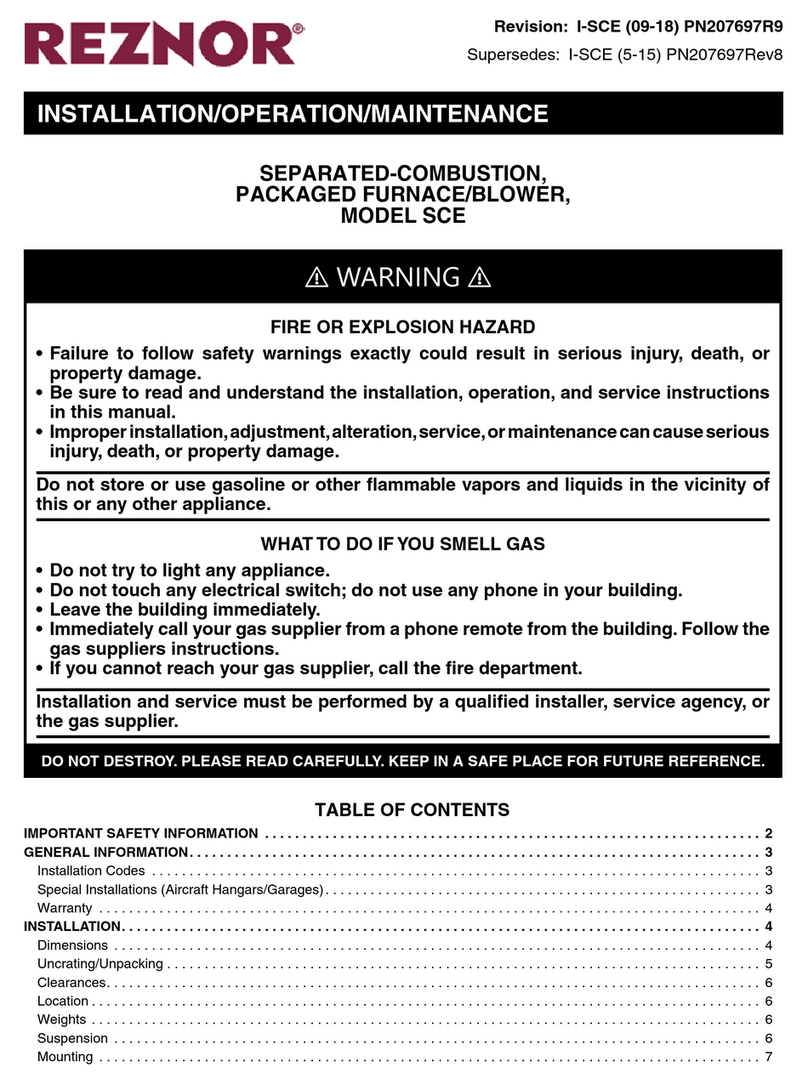
2SCE-IOM (01-22) 207697-B
TABLE OF CONTENTS
GENERAL INFORMATION ............................................................................. 3
References ........................................................................................ 4
Important Safety Information........................................................................... 4
Separated Combustion ............................................................................... 5
Installation Codes ................................................................................... 5
Special Installations (Aircraft Hangars/Garages) ........................................................... 5
Warranty .......................................................................................... 5
Dimensions ........................................................................................ 5
Weights........................................................................................... 7
Clearances ........................................................................................ 7
Location .......................................................................................... 7
Hazards of Chlorine ................................................................................. 7
INSTALLATION ...................................................................................... 8
Uncrating/Unpacking................................................................................. 8
Shipped-Separate Parts .............................................................................. 8
Suspension ........................................................................................ 9
Mounting .......................................................................................... 9
Duct Connections .................................................................................. 10
Requirements and Suggestions for Connecting and Installing Ducts ........................................ 11
Venting/Combustion Air Connections ................................................................... 12
Specific Venting Requirements: Piping ............................................................... 12
Specific Venting Requirements: Venter Outlet and Combustion Air Inlet Connections........................... 13
Specific Venting Requirements: Joints and Sealing ..................................................... 13
Specific Venting Requirements: Support.............................................................. 14
Specific Venting Requirements: Clearance ............................................................ 15
Specific Venting Requirements: Concentric Adapter Box ................................................. 15
Specific Venting Requirements: Concentric Adapter Box Pipe Connections .................................. 15
Vent Terminal Options............................................................................ 16
Vertical Vent Terminal (Option CC2) Installation........................................................ 17
Horizontal Vent Terminal (Option CC6) Installation...................................................... 22
Piping Connections................................................................................. 26
Gas Supply Pressure............................................................................. 26
Gas Supply Piping............................................................................... 27
Supply Piping Connections ........................................................................ 27
Condensate Drain Installation ...................................................................... 28
Electrical Connections .............................................................................. 29
Control Wiring .................................................................................. 29
CONTROLS ........................................................................................ 30
Thermostat ....................................................................................... 30
Combustion Air Proving Switch........................................................................ 30
Blower Fan Control ................................................................................. 31
Limit Control ...................................................................................... 31
Variable Frequency Drive ............................................................................ 31
Combination Gas Valve ............................................................................. 31
Optional Two-Stage Control (Heating Only Application)..................................................... 32
Optional Two-Stage Control (Makeup Air Application) ...................................................... 32
Optional Ductstat with Capillary Tubing (Option AG3) ................................................... 32
Optional Ductstat with Electronic Remote Setpoint Module (Option AG15 or AG16) ............................ 33
Optional Electronic Modulation ........................................................................ 33
Electronic Modulation Between 50% and 100% Firing Rate (Option AG7, AG8, or AG9) ........................ 33
Computer-Controlled Electronic Modulation Between 50% and 100% Firing Rate (Option AG21).................. 34
Electronic Modulation Between 20–28% and 100% Firing Rate (Option AG39) ................................ 34
Electronic Modulation Between 20–28% and 100% Firing Rate (Option AG40) ................................ 35




























